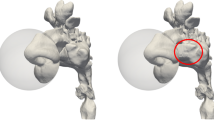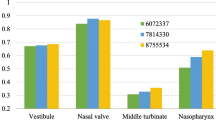Abstract
Computational fluid dynamics (CFD) is a mathematical tool to analyse airflow. As currently CFD is not a usual tool for rhinologists, a group of engineers in collaboration with experts in Rhinology have developed a very intuitive CFD software. The program MECOMLAND® only required snapshots from the patient’s cross-sectional (tomographic) images, being the output those results originated by CFD, such as airflow distributions, velocity profiles, pressure, temperature, or wall shear stress. This is useful complementary information to cover diagnosis, prognosis, or follow-up of nasal pathologies based on quantitative magnitudes linked to airflow. In addition, the user-friendly environment NOSELAND® helps the medical assessment significantly in the post-processing phase with dynamic reports using a 3D endoscopic view. Specialists in Rhinology have been asked for a more intuitive, simple, powerful CFD software to offer more quality and precision in their work to evaluate the nasal airflow. We present MECOMLAND® and NOSELAND® which have all the expected characteristics to fulfil this demand and offer a proper assessment with the maximum of quality plus safety for the patient. These programs represent a non-invasive, low-cost (as the CT scan is already performed in every patient) alternative for the functional study of the difficult rhinologic case. To validate the software, we studied two groups of patients from the Ear Nose Throat clinic, a first group with normal noses and a second group presenting septal deviations. Wall shear stresses are lower in the cases of normal noses in comparison with those for septal deviation. Besides, velocity field distributions, pressure drop between nasopharynx and the ambient, and flow rates in each nostril were different among the nasal cavities in the two groups. These software modules open up a promising future to simulate the nasal airflow behaviour in virtual surgery intervention scenarios under different pressure or temperature conditions to understand the effects on nasal airflow.





Similar content being viewed by others
References
André R, Vuyk H, Ahmed A, Graamans K, Nolst-Trenité G (2009) Correlation between subjective and objective evaluation of the nasal airway. a systematic review of the highest level of evidence. Clin Otolaryngol 34:518–525
Bailie N, Hanna B, Watterson J, Gallagher G (2006) An overview of numerical modelling of nasal airflow. Rhinology 44:53–57
Burgos M, Sanmiguel-Rojas E, Martín-Alcántara A, Hidalgo-Martínez M (2014) Effects of the ambient temperature on the airflow across a caucasian nasal cavity. Int J Numer Method Biomed Eng 30:430–445
Chen X, Lee H, Chong VH, Wang D (2009) Assessment of septal deviation effects on nasal air flow: a computational fluid dynamics model. Laryngoscope 119:1730–1736
Cole P (2000) Biophysics of nasal airflow: a review. Am J Rhinol 14:245–249
Elad D, Naftali S, Rosenfeld M, Wolf M (2006) Physical stresses at the air-wall interface of the human nasal cavity during breathing. J Appl Physiol 100:1003–1010
Farmer S, Eccles R (2007) Chronic inferior turbinate enlargement and the implications for surgical intervention. Rhinology 4:234–238
Fokkens W, Hellings P (2014) Objective measurements of nasal function: necessary before nasal surgery? Rhinology 52:289
Frank-Ito D, Kimbell J, Laud P, Garcia G, Rhee J (2014) Predicting post-surgery nasal physiology with computational modeling: current challenges and limitations. Otolaryngol Head Neck Surg 151:751–759
Grant O, Bailie N, Watterson J, Cole J, Gallagher G, Hanna B (2004) Numerical model of a nasal septal perforation. Stud Health Technol Inform 107:1352–1356
Hahn I, Scherer P, Mozell M (1993) Velocity profiles measured for airflow through a large-scale model of the human nasal cavity. J App Physiol 75:2273–2287
Ishikawa S, Nakayama T, Watanabe M, Matsuzawa T (2006) Visualization of flow resistance in physiological nasal respiration: analysis of velocity and vorticities using numerical simulation. Arch Otolaryngol Head Neck Surg 132:1203–1209
Leong S, Chen X, Lee H, Wang D (2010) A review of the implications of computational fluid dynamic studies on nasal airflow and physiology. Rhinology 48:139–145
Lorensen W, Cline H (1987) Marching cubes: a high resolution 3d surface construction algorithm. ACM Comput Graph 21:163–169
Quadrio M, Pipolo C, Corti S, Lenzi R, Messina F, Pesci C, Felisati G (2014) Review of computational fluid dynamics in the assessment of nasal air flow and analysis of its limitations. Eur Arch Otorhinolaryngol 271:2349–2354
Taylor D, Doorly D, Schroter R (2010) Inflow boundary profile prescription for numerical simulation of nasal airflow. J R Soc Interface 151:751–759
Wang D, Lee H, Gordon B (2012) Impacts of fluid dynamics simulation in study of nasal airflow physiology and pathophysiology in realistic human three-dimensional nose models. Clin Exp Otorhinolaryngol 5:181–187
Wang Y, Liu Y, Sun X, Yu S, Gao Y (2009) Numerical analysis of respiratory flow patterns within human upper airway. Acta Mech Sin 25:737–746
Weinhold I, Mlynski G (2004) Numerical simulation of airflow in the human nose. Eur Arch Otorhinolaryngol 261:452–455
Wen J, Inthavong K, Tu J (2008) Numerical simulations for detailed airflow dynamics in a human nasal cavity. Respir Physiol Neurobiol 161:125–135
**ong G, Zhan J, Jiang H, Li J, Rong L, Xu G (2008) Computational fluid dynamics simulation of airflow in the normal nasal cavity and paranasal sinuses. Am J Rhinol 22:477–482
Zachow S, Muigg P, Hildebrandt T, Doleisch H, Hege H (2009) Visual exploration of nasal airflow. IEEE Trans Vis Comput Graph 15:1407–1414
Zhao K, Jiang J (2014) What is normal nasal airflow? A computational study of 22 healthy adults. Int Forum Allergy Rhinol 4:435–446
Zhao K, Pribitkin E, Cowart B, Rosen D, Scherer P, Dalton P (2006) Numerical modeling of nasal obstruction and endoscopic surgical intervention: outcome to airflow and olfaction. Am J Rhinol 20:308–316
Zubair M, Abdullah M, Ismail R, Shuaib I, Hamid S, Ahmad K (2011) Review: a critical overview of limitations of CFD modeling in nasal airflow. J Med Biol Eng 32:77–84
Acknowledgements
The authors acknowledge the access to the patient database of the University Hospital Virgen del Rocío of Sevilla (Spain). Authors also thank Medical Doctor Vania Nova Juiz and Fco. M. Piqueras Pérez from Hospital Morales Meseguer of Murcia (Spain) for their helpful comments to improve the programs MECOMLAND® and NOSELAND®.
Author information
Authors and Affiliations
Corresponding author
Ethics declarations
Conflict of interest
The authors declare that they have no conflict of interest.
Ethical approval
All procedures performed in studies involving human participants were in accordance with the ethical standards of the institutional and/or national research committee and with the 1964 Helsinki declaration and its later amendments or comparable ethical standards.
Financial disclosure
None reported.
Informed consent
Informed consent was obtained from all individual participants included in the study.
Rights and permissions
About this article
Cite this article
Burgos, M.A., Sanmiguel-Rojas, E., del Pino, C. et al. New CFD tools to evaluate nasal airflow. Eur Arch Otorhinolaryngol 274, 3121–3128 (2017). https://doi.org/10.1007/s00405-017-4611-y
Received:
Accepted:
Published:
Issue Date:
DOI: https://doi.org/10.1007/s00405-017-4611-y




